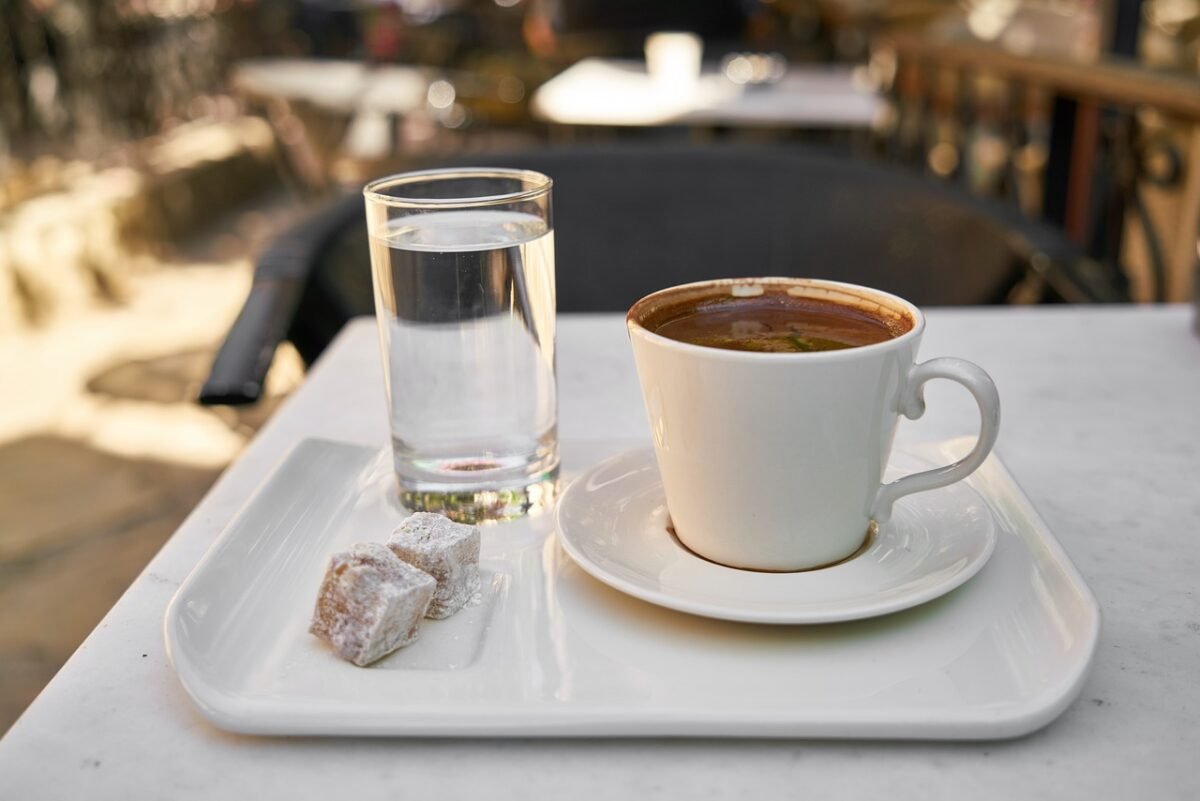There’s something deeply personal about brewing Turkish coffee at home. It’s more than a caffeine kick — it’s a ritual, a tradition, and an experience rooted in centuries of culture. Whether you’re reminiscing about a trip to Istanbul or just craving a bold, rich cup, this 2025 guide will walk you through how to make Turkish coffee the authentic way — no fancy machines required.
Quick Overview:
Prep time: 3 minutes
Cook time: 5–7 minutes
Servings: 1 traditional cup
Difficulty: Easy (but requires attention to detail)
What Is Turkish Coffee?

Turkish coffee is a style of unfiltered coffee made in a small copper pot called a cezve (or ibrik), using ultra-fine ground Arabica beans. It’s known for its thick, velvety texture, rich flavor, and iconic foam (köpük) on top. Traditionally served in a small demitasse cup with a glass of water and something sweet like lokum (Turkish delight), it’s more than just a drink — it’s an invitation to slow down.
What You’ll Need (Authentic Ingredients & Tools)
To replicate the full Turkish coffee experience at home, here’s what you’ll need:
Ingredients:
Cold filtered water – 75 ml (a bit less than 1/3 cup)
Finely ground Turkish coffee – 1 heaping teaspoon
Sugar (optional) – add according to your preference
Cardamom (optional) – 1 pinch for a traditional twist
Tools:
Cezve (small long-handled copper pot) – A must for that authentic brew
Demitasse cup – Holds about 60–90 ml
Small spoon – For gentle stirring
Heat source – Gas stovetop or portable burner (avoid electric stovetops if possible)
Tip: You can buy freshly ground Turkish coffee or grind your own Arabica beans using a burr grinder set to extra-fine (powder-like). For authentic Turkish coffee and gear, check out Turkish Coffee World — they ship internationally.
Step-by-Step: How to Make Turkish Coffee at Home

Follow these steps carefully — Turkish coffee isn’t difficult, but precision and patience make all the difference.
1. Measure the Water
Pour cold filtered water into the cezve using the same cup you’ll serve in. One serving = one cup.
2. Add the Coffee and Sugar
Add 1 heaping teaspoon of Turkish coffee per cup (do not stir yet). Then add sugar only if desired:
No sugar = sade
A little sugar = az şekerli (½ tsp)
Medium = orta (1 tsp)
Sweet = şekerli (2 tsp)
- You can also add a pinch of cardamom here for a traditional flavor boost.
3. Stir Gently Before Heating
Mix the contents just until dissolved — this is the only time you stir.
4. Slowly Heat It Up
Place the cezve over low heat. This slow heating is crucial — it allows the flavor to fully develop. Do not stir again.
5. Watch the Foam (Köpük)
As the coffee heats, foam will rise. Just before it overflows, remove the cezve and let the foam settle. Scoop a bit of foam into your cup. Return the cezve to the heat and repeat this once or twice for a thicker brew.
6. Serve Without Filtering
Gently pour the coffee into your cup. Don’t stir or sip too fast — the grounds settle at the bottom.
How It's Traditionally Served in Turkey
With a glass of cold water – to cleanse the palate before sipping
A small piece of Turkish delight (lokum) – to balance the bitterness
Often followed by a playful coffee fortune-telling ritual (tasseography) using the grounds
Turkish saying: “A cup of coffee commits one to forty years of friendship.” That’s how sacred the ritual is.
Tips for Mastering Turkish Coffee
Never boil it hard – It ruins the foam and flavor.
Use copper cezve with tin lining – Distributes heat evenly.
Don’t serve immediately after brewing – Let the grounds settle for 30–60 seconds.
Use soft water – Hard water can make the coffee cloudy.
FAQ: Turkish Coffee in 2025
Q: Can I use regular espresso or French press grind?
No. Turkish coffee needs an extra-fine, powdery grind. Espresso is too coarse and won’t create the same texture or foam.
Q: Is it stronger than espresso?
It’s not about caffeine but intensity and texture. Turkish coffee feels rich and dense, but it usually contains less caffeine than espresso per ounce.
Q: Where can I buy authentic Turkish coffee?
For trusted brands like Kurukahveci Mehmet Efendi, check out Amazon or Istanbul Grand Bazaar for international delivery.
Turkish Coffee vs. Other Coffee Styles

| Feature | Turkish Coffee | Espresso | French Press |
|---|---|---|---|
| Grind Size | Ultra-fine (powder) | Fine | Coarse |
| Brewing Time | 5–7 minutes | 25–30 seconds | 4–6 minutes |
| Texture | Thick and sludgy | Smooth and dense | Full-bodied |
| Filtered? | No | Yes | Yes |
| Origin | Turkey / Middle East | Italy | France |
Final Thoughts: A Timeless Ritual You Can Master
Making authentic Turkish coffee at home in 2025 is a small but meaningful daily ritual. It’s meditative, flavorful, and deeply cultural — the kind of brew that reminds you to pause. Whether you’re serving guests or simply treating yourself, each cup holds history, hospitality, and harmony.
So grab your cezve, pour slowly, and enjoy the quiet magic of a centuries-old tradition.




